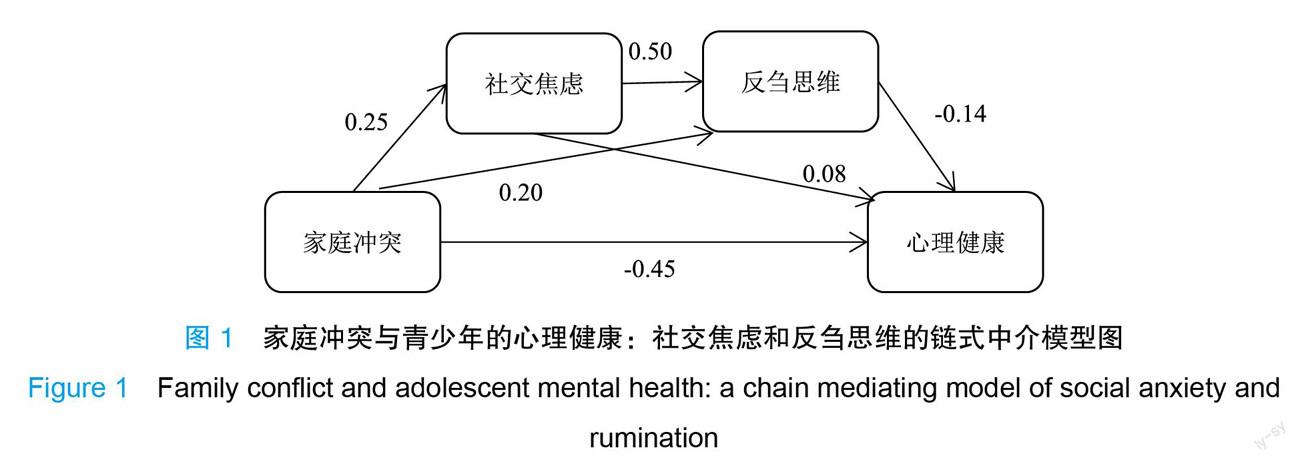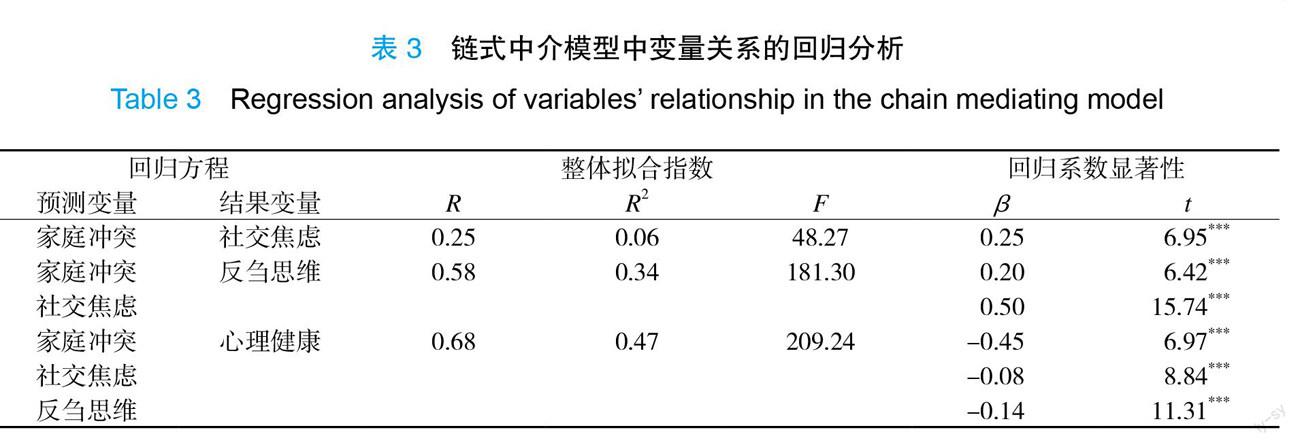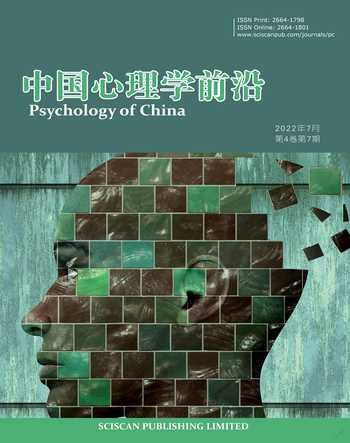家庭冲突对青少年心理健康的影响:社交焦虑和反刍思维的链式中介作用
王若丹



摘 要|目的:本研究考察家庭冲突与青少年心理健康的关系及社交焦虑和反刍思维在其中所产生的影响。方法:采用家庭环境量表中的冲突分量表、青少年社交焦虑量表、反刍反应量表和长处与困难问卷对 717 名青少年进行调查。结果:(1)青少年家庭冲突、社交焦虑和反刍思维两两之间呈显著正相关,青少年的心理健康与 家庭冲突、社交焦虑和反刍思维呈显著负相关;(2)链式中介效应结果表明,青少年的家庭冲突通过社交 焦虑和反刍思维影响其心理健康水平,其中家庭冲突→社交焦虑→心理健康的中介效应值为 0.073;家庭冲突→反刍思维→心理健康的中介效应值为 0.077;家庭冲突→社交焦虑→反刍思维→心理健康的中介效应值为 0.047,以上经检验均为显著相关。结论:状态焦虑和反刍思维在家庭冲突与青少年心理健康之间起链式中介作用,家庭冲突不仅可以直接影响青少年的心理健康,还可以通过社交焦虑和反刍思维产生间接影响。
关键词|家庭冲突;心理健康;社交焦虑;反刍思维;青少年
Copyright ? 2022 by author (s) and SciScan Publishing Limited
This article is licensed under a Creative Commons Attribution-NonCommercial 4.0 International License. https://creativecommons.org/licenses/by-nc/4.0/
1 前言
近年來,青少年的心理健康成为公众关注的热点话题,教育部网站也多次下发关于提升青少年心理健康水平的通知。由于青少年所处时期的特殊性(生理发育及周边环境的变化),这一群体的情绪调节较弱、情绪反应较强,加之社会敏感性带来的压力增大,容易使得他们出现焦虑、抑郁等症状[1]。薛 云云等人(2019)发现目前青少年心理健康问题形势较为严峻,因心理疾病所就诊的人数呈逐年上升的趋势,并且具有低龄化、多元复杂性等特点[2]。因此,研究青少年心理健康的影响因素及作用机制, 并及时进行干预都是十分必要的。
影响青少年心理健康的因素多种多样,其中家庭问题扮演着重要角色[3]。研究表明,家庭冲突是青少年抑郁症状的预测因子,它会导致青春期孩子心理社会功能的恶化[4-6]。家庭中存在的不和谐形 式(争论、争吵、暴力等)会破坏稳定的家庭系统,使青少年产生恐慌情绪进而导致其适应问题的发 生[7]。在基因—环境的相互作用下,家庭冲突会增加具有抑郁家庭遗传史的儿童心理疾病症状发生的 风险[8,9]。积极的家庭关系可以促进青少年取得更高的教育和职业成就,而不良的家庭关系会导致青 少年自杀行为的发生和较差的健康状况[10]。以低表达力、低凝聚力和激烈冲突为特征的家庭环境往 往会导致青少年出现问题行为和心理疾病[11]。家庭冲突作为青少年的压力性生活事件,会使得他们 感受到巨大的家庭压力及缺乏家庭支持,从而造成心理社会方面的问题[12]。由此可见,家庭冲突作 为一种负面因素,可能会对青少年心理健康产生不良影响。因此,本研究进行假设 1:家庭冲突能负向预测青少年的心理健康。
研究表明,家庭冲突会增加青少年同伴关系的压力,导致人际脆弱性,从而出现抑郁症状[13],所以需要讨论青少年的社交领域在家庭冲突影响其心理健康过程中所起的作用。社交焦虑是指个体对一 种或多种人际环境有强烈的忧虑、紧张或恐惧的情绪反应和回避行为[14]。社交焦虑会增加青少年的人际敏感度并降低其自尊水平,这些最终导致了青少年不良问题行为的发生[15]。丹妮尔等人(Danneel et al.,2019)的研究发现,社交焦虑是青春期出现孤独感和心理问题的助推器,社交焦虑行为的发生会削弱友谊,进而遭到同伴拒绝,经历绝望感[16]。青少年感知到的家庭问题与他们的社交互动问题(社交焦虑和社交回避)存在相关[17]。通过对家庭不良环境中成员表达情绪(批评、敌意、情绪过度等)的评估,青少年的社交焦虑症状会加剧,从而导致抑郁的发生[18]。因此,本研究进行假设 2:社交焦虑在家庭冲突和青少年心理健康状况间起中介作用。
不良的家庭环境会使得青少年进行反刍,这是抑郁风险的危险性因素[19]。反刍思维是指个体不断地主动思考已发生的负性生活事件,包括事件的起因、意义及可能产生的结果等[20]。它会预测一般内化症状的轨迹,与外化行为波动的相互作用,并使得抑郁症状的预期水平升高[21]。家庭问题等压力源提升了早期青少年的反刍率,使得发生共同反刍效应并且增加消极行为,减少社会支持,最终出现心理问题的易感性升高的结果[22]。家庭环境紧张等高压的生活事件会引发青少年消极思维的产生,过度“回看”的反应方式对青少年的抑郁症状患病率的解释占比高[23]。因此,本研究进行假设 3:反刍思维在家庭冲突和青少年心理健康状况间起中介作用。
约瑟等人(Jose et al.,2012)的研究表明,对社交互动的焦虑和回避可以直接预测青少年更高的反刍水平[24]。社交焦虑的严重程度和对社交表现的负面自我评价会明显影响社交事件发生后一周内 的反刍思维[25]。与心理健康的对照组相比,具有社交焦虑的个体报告存在更多的反刍思维与担忧状 态,并且同时具有社交焦虑和重度抑郁症的患者组报告的反刍思维和担忧状态程度更深[26]。根据反 应风格理论,反刍思维是社交焦虑和抑郁的认知风险性因素,渴望给别人留下好印象并害怕被他人拒 绝的青少年会常常回想在他们身上发生的事情和感受,从而心理变得不健康[27]。简而言之,更多的 社交焦虑的人更容易陷入反刍境地,从而引发许多不良的情绪后果,更容易表现抑郁症状[28]。此外, 有研究表明,家庭冲突会增加青少年社交恐惧症和反刍思维发生的概率,增加他们的内化问题并减少 主观幸福感[29]。因此,本研究进行假设 4:社交焦虑和反刍思维在家庭冲突和青少年心理健康状况间起链式中介作用。
2 研究方法
研究对象
本研究采用整群方便抽样,对浙江省某中学 750 名初中生进行线下问卷调查,最终剔除乱填、缺填后共收集到有效问卷 717 份,问卷回收有效率为 95.6%。其中,男生 378 名,女生 339 名;城镇 456 名,农村 261 名;双亲家庭 663 名,非双亲家庭 54 名;独生子女 252 名,非独生子女 465 名。
研究工具
家庭冲突
家庭冲突使用家庭环境量表[30]的冲突分量表进行评估,该分量表包括提供家庭冲突证据的 9 个 2分问题,用于评估家庭中冲突频率和激烈的程度。量表总分范围为 0 到 9 分,得分越高说明家庭冲突程度越大。此量表在本研究中的 Cronbachs α 系数为 0.82。
社交焦虑
使用青少年社交焦虑量表(SAS)[31]评估学生对社交焦虑的主观体验。向学生提供了总共 22 个反映活动和社会偏好的项目,项目为 5 点李克特计分,得分越高说明社交焦虑程度越高。此量表在本研究中的 Cronbachs α 系数为 0.92。
反刍思维
用反刍反应量表(RRS)[32]进行测量,共 22 个项目。参与者以 4 分制(1=“从不”,4=“总是”) 对每个项目进行评分,分数越高表示反刍倾向越高。此量表在本研究中的 Cronbachs α 系数为 0.92。
心理健康
使用長处与困难问卷(SDQ)[33]。SDQ 由分布在五个子量表中的总共 25 个陈述组成:情绪问题、行为问题、多动症、同伴问题和亲社会行为,具有三个选项的李克特类型格式(0=“不真实”,1=“有点真实”,2=“完全真实”)。本研究去除亲社会维度量表,采用前四个维度测量青少年的心理健康水平。此量表在本研究中的 Cronbachs α 系数为 0.77。
数据处理
采用 SPSS 26.0 对数据进行共同方法偏差检验、描述性统计及相关分析,采用 Process 3.3 宏程序的 Bootstrap 法进行中介效应检验。
3 结果
共同方法偏差检验
通过 Harman 单因子检验,结果显示特征根大于 1 的因子共 15 个,第一个公因子的方差贡献量为 22.394%,低于 40%,说明本研究不存在严重的共同方法偏差。
描述性统计及相关分析
对数据进行描述性统计和相关分析得到的结果如表1 所示,由此可知,家庭冲突、社交焦虑、反刍思维和心理健康之间存在显著相关(p<0.001),其中家庭冲突、社交焦虑、反刍思维两两之间存在显著正相关(p<0.001),这三个维度又与青少年的心理健康存在显著负相关(p<0.001)。
中介效应检验
利用 SPSS 中宏程序 Process 3.3 的模型 6 进行中介效应分析,以家庭冲突作为自变量,青少年的心理健康作为因变量,社交焦虑和反刍思维作为中介变量,得到本研究所构建的链式中介效应模型检验结果,如表2 所示,其中总间接效应值为 0.196,Boot CI 上下限不包含 0;间接效应 1 显著,家庭冲突→社交焦虑→心理健康的间接效应值为 0.073;间接效应 2 显著,家庭冲突→反刍思维→心理健康的间接效应值为 0.077;间接效应 3 显著,家庭冲突→社交焦虑→反刍思维→心理健康的间接效应值为 0.047。
由表3 的链式中介模型中变量关系的回归分析可知,家庭冲突对青少年心理健康具有显著的负向预测作用(β =-0.45,p<0.001),家庭冲突对社交焦虑和反刍思维均存在显著的正向预测作用(β =0.25,p<0.001;β =0.20,p<0.001),社交焦虑显著正向预测反刍思维(β =0.50, p<0.001),社交焦虑和反刍思维对青少年的心理健康具有显著负向预测作用(β =-0.08,p<0.001; β =-0.14,p<0.001),见图 1。
4 讨论
本研究探讨了家庭冲突对青少年心理健康的影响及作用机制,由结果可知,所提4 个假设均得到验证, 家庭冲突、社交焦虑、反刍思维和青少年心理健康两两之间均存在显著相关关系,家庭冲突既可以直接预测青少年的心理健康,也可以通过社交焦虑和反刍思维间接影响青少年的心理健康。
首先,家庭冲突显著负向预测青少年的心理健康。家庭冲突是青少年内外化问题形成的重要原因之一,父母的争吵、打架及冷暴力等紧张的家庭关系会让孩子直接暴露在极大的压力源中,从而引发心理问题[34]。有学者也从生理角度验证了家庭冲突与青少年抑郁的关系——家庭冲突会通过海马体与双侧 眶额皮质的连接影响青少年的抑郁症状[35]。当家庭冲突水平高时,青少年更容易沮丧、焦虑和愤怒, 会具有更低落的情绪和更无力的生活行动,这也扩展了胁迫理论的相关研究[36]。由此,青少年家庭成 员应增强内部凝聚力,积极主动地与内部成员进行沟通来消弭潜在矛盾,使得家庭氛围更加和谐与温馨, 尽可能减少家庭关系带给青少年的不良压力源以提升青少年的心理健康水平。
其次,社交焦虑在家庭冲突和青少年心理健康之间起中介作用,家庭冲突正向预测社交焦虑,社交焦虑负向预测青少年的心理健康。不良的家庭环境会使得青少年出现社交焦虑和社交回避,使得青少年在社交过程中表现出适应困难[37]。家庭凝聚力强、家庭冲突低水平的青少年社交焦虑程度较低,能够积极地与周围人进行互动,心理健康水平更高[38]。相反,争吵、打架等“令人窒息”的家庭氛围容易使得青少年家庭支持减弱、自信心下降,在面对人际关系时出现过度焦虑、紧张、回避的现象,从而造成孤独感增加、心情沮丧压抑等负面情绪状态的出现,导致心理健康水平下降。
最后,反芻思维在家庭冲突和青少年心理健康之间起中介作用,家庭冲突正向预测反刍思维,反刍思维负向预测青少年的心理健康。家庭冲突会触发青少年的情绪困扰和情感障碍,这诱发了后续的一系列反刍思维的出现[39]。更高水平的反刍思维又是青春期这一成长过渡期的抑郁症易感因素[40]。青少 年过度回想家庭中发生的不良冲突事件(不良压力源),会使得他们变得更加焦虑、沮丧,这促发了青少年群体不健康心理状态的出现。因此,家庭营造和谐美好的氛围,可以减少青少年对“不美好场景” 的反刍,使得青少年拥有健康、积极的阳光心态。
本研究探讨了家庭冲突对青少年心理健康的关系及作用机制,验证了社交焦虑和反刍思维在家庭冲突和青少年心理健康之间起到的链式中介作用。当青少年经历家庭争吵、暴力等具有较高压力源属性的事件时,会产生较高的社交焦虑水平,从而导致他们容易在社交中回避、退缩,对人际交往更加敏感、恐惧与抵触,进而引发对负性生活事件的过度思考,产生不良情绪等。因此,本研究认为应该做好家庭心理教育的宣传工作,使家长们意识到营造和谐、友好的家庭氛围的重要性,培养青少年良好的交友心态及观念,教给他们面对人际关系的技巧,使他们掌握应对不良事件的正确态度及处理办法,从而帮助青少年顺利地度过青春期,提高他们的心理健康水平。
参考文献
[1]Magson N R,Freeman J Y,Rapee R M,et al.Risk and protective factors for prospective changes in adolescent mental health during the COVID-19 pandemic[J].Journal of youth and adolescence,2021,50(1):44- 57.
[2]薛云云,肖煜吟,付航,等.青少年心理健康现状及改善对策:基于上海市3家医院的调查结果[J]. 中国卫生政策研究,2019,12(2):65-69.
[3]Speyer L G,Hall H A,Hang Y,et al.Within-family relations of mental health problems across childhood and adolescence[J].Journal of Child Psychology and Psychiatry,2022.
[4]Herrenkohl T I,Kosterman R,Hawkins J D,et al.Effects of growth in family conflict in adolescence on adult depressive symptoms:Mediating and moderating effects of stress and school bonding[J].Journal of Adolescent Health,2009, 44(2):146-152.
[5]Tang X,Tang S,Ren Z,et al.Psychosocial risk factors associated with depressive symptoms among adolescents in secondary schools in mainland china:a systematic review and meta-analysis[J].Journal of affective disorders,2020( 263):155-165.
[6]Khajenouri B,Dehqani R.Adolescents problems and their relationship with family institution: the case study of parental conflicts and adolescents mental health[J].Journal of Sociology of Social Institutions,2016,3(7):66-37.
[7]Cummings E M,Koss K J,Davies P T.Prospective relations between family conflict and adolescent maladjustment:Security in the family system as a mediating process[J].Journal of abnormal child psychology,2015,43(3):503-515.
[8]Rice F,Harold G T,Shelton K H,et al.Family conflict interacts with genetic liability in predicting childhood and adolescent depression[J].Journal of the American Academy of Child & Adolescent Psychiatry,2006,45(7):841-848.
[9]Blakemore S J.Adolescence and mental health[J].The lancet,2019,393(10185):2030-2031.
[10]Chhabra G S,Sodhi M K.Impact of family conflict on the psychosocial behaviour in male adolescents[J]. Journal of Nepal Paediatric Society,2012,32(2):124-131.
[11]Sela Y,Zach M,Amichay-Hamburger Y,et al.Family environment and problematic internet use among adolescents:the mediating roles of depression and fear of missing out[J].Computers in Human Behavior, 2020(106):106226.
[12]Carballo J J,Llorente C,Kehrmann L,et al.Psychosocial risk factors for suicidality in children and adolescents[J].European child & adolescent psychiatry,2020,29(6):759-776.
[13]Auerbach R P,Ho M H R.A cognitive-interpersonal model of adolescent depression:the impact of family conflict and depressogenic cognitive styles[J].Journal of Clinical Child & Adolescent Psychology,2012,41
(6):792-802.
[14]孙梦圆,刘堃,刘丽,等.精简版青少年社交焦虑量表在初中生人群中的信效度评价[J].现代预防 医学,2017,44(23):4310-4313.
[15]You Z,Zhang Y,Zhang L,et al.How does self-esteem affect mobile phone addiction? The mediating role of social anxiety and interpersonal sensitivity[J].Psychiatry research,2019( 271):526-531.
[16]Danneel S,Nelemans S,Spithoven A,et al.Internalizing problems in adolescence:Linking loneliness, social anxiety symptoms,and depressive symptoms over time[J].Journal of abnormal child psychology, 2019,47(10):1691-1705.
[17]Johnson H D,Lavoie J C,Mahoney M.Interparental conflict and family cohesion: Predictors of loneliness, social anxiety,and social avoidance in late adolescence[J].Journal of adolescent research,2001,16(3):304-318.
[18]Greca A M L,Ranta K.Developmental transitions in adolescence and their implications for social anxiety[M]
//In Social anxiety and phobia in adolescents.Springer Cham,2015:95-117.
[19]Gaté M A,Watkins E R,Simmons J G,et al.Maternal parenting behaviors and adolescent depression: The mediating role of rumination[J].Journal of Clinical Child & Adolescent Psychology,2013,42(3):348- 357.
[20]鄧金艳,姜淑梅.反刍思维述评[J].心理月刊,2022,17(5):235-237.
[21]Hankin B L.Rumination and depression in adolescence: Investigating symptom specificity in a multiwave prospective study[J].Journal of Clinical Child & Adolescent Psychology,2008,37(4):701-713.
[22]Bastin M,Mezulis A H,Ahles J,et al.Moderating effects of brooding and co-rumination on the relationship between stress and depressive symptoms in early adolescence:A multi-wave study[J].Journal of Abnormal Child Psychology,2015,43(4):607-618.
[23]Young C C.Familial factors,cognitive vulnerabilities,and stressful events related to depressive symptoms in Latino adolescents[J].Hispanic Journal of Behavioral Sciences,2016,38(3):360-377.
[24]Jose P E,Wilkins H,Spendelow J S.Does social anxiety predict rumination and co-rumination among adolescents[J].Journal of Clinical Child & Adolescent Psychology,2012,41(1):86-91.
[25]Chen J,Rapee R M,Abbott M J.Mediators of the relationship between social anxiety and post-event rumination[J].Journal of anxiety disorders,2013,27(1):1-8.
[26]Arditte Hall K A,Quinn M E,Vanderlind W M,et al.Comparing cognitive styles in social anxiety and major depressive disorders: An examination of rumination,worry,and reappraisal[J].British Journal of Clinical
Psychology,2019,58(2):231-244.
[27]Orue I,Calvete E,Padilla P.Brooding rumination as a mediator in the relation between early maladaptive schemas and symptoms of depression and social anxiety in adolescents[J].Journal of adolescence,2014, 37(8):1281-1291.
[28]Kashdan T B,Roberts J E.Social anxiety,depressive symptoms,and post-event rumination:Affective consequences and social contextual influences[J].Journal of Anxiety Disorders,2007,21(3):284- 301.
[29]Watkins N K,Salafia C,Ohannessian C M.Family Functioning and Anxiety Symptoms in Adolescents: The Moderating Role of Mindfulness[J].Journal of Child and Family Studies,2022,31(5):1474-1488.
[30]Moos R H,Moos B S.Family Environment Scale manual [M].3rd ed.Palo Alto,CA:Mind Garden, 2022.
[31]La Greca A M,Lopez N.Social anxiety among adolescents:linkages with peer relations and friendships[J]. Journal of Abnormal Child Psychology,1998,26(2):83–94.
[32]S Nolen-Hoeksema,J Morrow.A prospective study of depression and posttraumatic stress symptoms after a natural disaster:The 1989 Loma Prieta Earthquake[J].Journal of Personality and Social Psychology, 1991,61(1):115-121.
[33]R Goodman.The strengths and difficulties questionnaire:a research note[J].J Child Psychol Psychiatry, 1997(38 ):581-586.
[34]David C,Steele R,Forehand R,et al.The role of family conflict and marital conflict in adolescent functioning[J].Journal of Family Violence,1996,11(1):81-91.
[35]Feng R,Bao W,Zhuo L,et al.Family Conflict Associated With Intrinsic Hippocampal-OFC Connectivity in Adolescent Depressive Disorder[J].Frontiers in Psychiatry,2022(12):797-898.
[36]Fosco G M,Lydon-Staley D M.Implications of family cohesion and conflict for adolescent mood and well- being:Examining within-and between-family processes on a daily timescale[J].Family Process,2020,59(4):1672-1689.
[37]Johnson H D,Lavoie J C,Mahoney M.Interparental conflict and family cohesion: Predictors of loneliness, social anxiety,and social avoidance in late adolescence[J].Journal of adolescent research,2001,16
(3):304-318.
[38]Mak H W,Fosco G M,Feinberg M E.The role of family for youth friendships:Examining a social anxiety mechanism[J].Journal of youth and adolescence,2018,47(2):306-320.
[39]Prioste A,Tavares P,Silva C S,et al.The relationship between family climate and identity development processes:the moderating role of developmental stages and outcomes[J].Journal of Child and Family Studies,2020,29(6):1525-1536.
[40]Abela J R,Hankin B L.Rumination as a vulnerability factor to depression during the transition from early to middle adolescence:a multiwave longitudinal study[J].Journal of abnormal psychology,2022,120(2):259.
The Impact of Family Conflict on Adolescents Mental Health: The Chain Mediating Effect of Social Anxiety and Rumination
Wang Ruodan
College of Education, Zhejiang University of Technology, Hangzhou
Abstract: Objective: This study examined the relationship between family conflict and adolescents mental health and the influence of social anxiety and rumination. Methods: 717 adolescents were surveyed using the conflict subscale of the Family Environment Scale, the Adolescent Social Anxiety Scale, the Rumination Response Scale and the Strengths and Difficulties Questionnaire. Results: (1) There was a significant positive correlation among adolescents family conflict, social anxiety and rumination, and adolescents mental health was significantly negatively correlated with family conflict, social anxiety and rumination; (2) The results of the chain mediating effect show that the family conflict of adolescents affects their mental health through social anxiety and rumination, and the mediating effect value of “family conflict→social anxiety→mental health” is 0.073; the mediating effect value of “family conflict→rumination→mental health” is 0.077; the mediating effect value of “family conflict→social anxiety→rumination→mental health” is 0.047, and the above mediating effect values are significant. Conclusion: State anxiety and rumination play a chain mediating role between family conflict and adolescents mental health. Family conflict can not only directly affect adolescents mental health, but also indirectly affect affect through social anxiety and rumination.
Key words: Family conflict; Mental health; Social anxiety; Rumination; Adolescent

